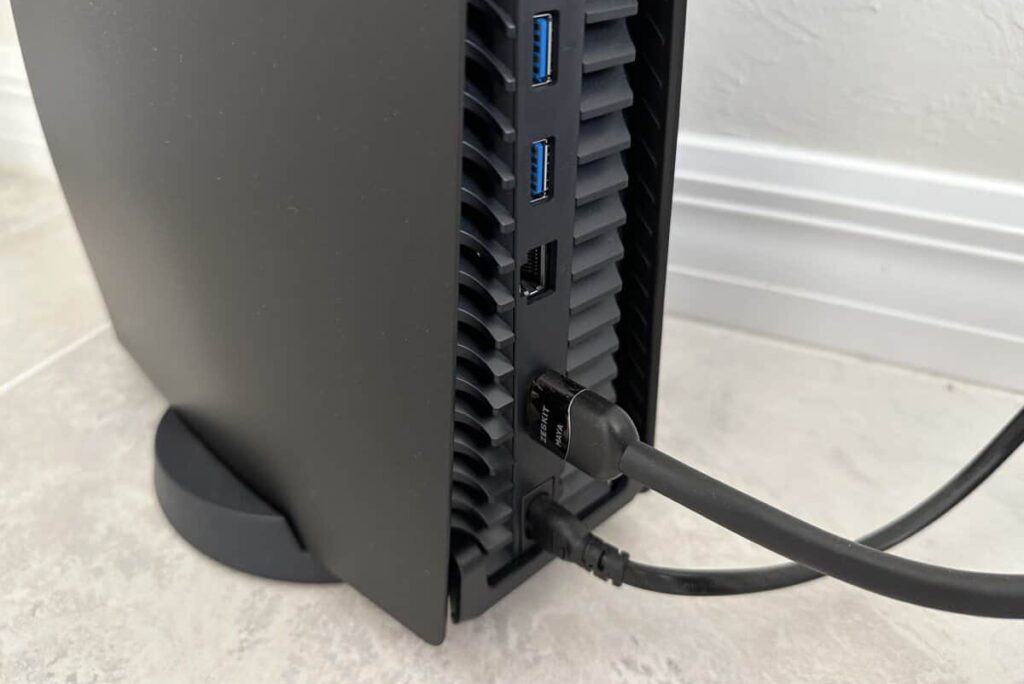So you finally got your hands on a new PS5. Considering how expensive and exclusive the PS5 system is, I’m sure you want it to run at its highest capacity for your games to look as good as possible when you’re playing them. This probably leaves you wondering whether or not you should buy a new upgraded HDMI 2.1 cord specifically for the PS5 system.
You can use a PS5 with HDMI 2.0 and display up to 60 frames per second at 4K resolution. HDMI 2.1 is only required for games running 8K resolution at 60 frames per second, or 4K resolution at 120 frames per second.

What I just said probably sounds like absolute nonsense to less experienced gamers, but don’t worry. In the paragraphs below, I’ll explain in-depth the differences between HDMI 2.0 and 2.1, which one is best, and how to optimize each for your system.
Using HDMI 2.0 With the PS5
Before you panic and think you need a new HDMI cable—or, heaven forbid, a new TV—let me assure you that your old HDMI 2.0 ports and cables will work with your new PS5. However, there are a few limitations.
You will not be getting the most optimal graphics experience. Your games will not be playing at the highest frame rate. The frame rate is the number of images displayed each second. The Higher the frame rate, the smoother the image on the screen appears.
HDMI 2.0 is not bad by any means. It can display 4KHD video at 60 frames per second and 8K video at 30 frames per second. For reference, the human brain can only process about 10-12 frames per second; the brain perceives anything greater than that in full motion. So, your games won’t seem choppy or laggy with an HDMI 2.0. They’ll look just fine.
Using HDMI 2.1 With the PS5
As I mentioned, your games will play and look just fine with HDMI 2.0. However, certain games and other content will look a lot smoother and play at a much higher resolution with HDMI 2.1.
While HDMI 2.0 can display images in 8KHD at only 30 frames per second, HDMI 2.1 doubles that figure at 60 FPS and doubles up HDMI 2.0 in 4KHD resolution at 120 frames per second, compared to 60 frames per second for HDMI 2.0.
HDMI 2.1 can support up to 10K resolution, but the gaming and film industry hasn’t reached that point yet.
HDMI 2.0 vs. HDMI 2.1: Which Is Better for PS5?
The thing about gaming—especially the ever-growing online gaming—is that you want the experience to be as seamless as possible. A seamless experience makes you feel almost as if the controller is an extension of your body as you react in real-time to the on-screen stimuli.
HDMI 2.1 is better for PS5 gaming. While HDMI 2.0 can give you a quality experience on a basic level because of the advanced hardware of the PS5 console itself, HDMI 2.1 can take your experience to an even higher level with higher frame rates at higher picture quality resolutions.
In the simplest terms, HDMI 2.1 can play your games, movies, and tv shows in high picture quality at very high frames per second. The picture will look crisp, and the motion on the screen will be ultra-smooth. This is ideal for gaming and watching movies.
Consider Price Constraints
It’s also important to note that budgetary constraints can be a deciding factor in which HDMI cable you choose to use with your PS5.
You can find an HDMI 2.1 cable for a reasonable price, and it will certainly raise your frame rate, giving you smoother on-screen action. If you choose to take this route, I would recommend this PEUZAVA 48Gbps Ultra High-Speed HDMI 2.1 Cord on Amazon. It’s compatible with an array of gaming systems (including the PS5) and comes at a reasonable price.
However, an 8K TV is much more expensive than its 4K counterparts. As mentioned above, the PS5 doesn’t even support 8K output. So, setting up your PS5 system with 8K gaming in mind is not a great option yet.
The Final Verdict
The answer here on HDMI 2.0 vs. HDMI 2.1 is very clear. HDMI 2.1 provides a ton of processing power, but all that power is not necessary. 8K gaming is not mainstream yet; the PS5 doesn’t even support 8K output even though it has the HDMI 2.1 slot. Sony caps the resolution at 4K.
Even PS5 games with enhanced graphics run at 4K resolution and 60 frames per second, which is fully achievable by an HDMI 2.0 cable. An HDMI 2.1 cable is complete overkill unless you’re a professional gamer looking for that little extra edge.
In the end, your PS5 will work fine if you use an HDMI 2.0 cable and port. In addition, the fact that PS5 does not yet support 8K output makes HDMI 2.0 the best option between HDMI 2.0 and HDMI 2.1. You can still play your games in 4K resolution at 60 frames per second, which is the resolution and frame rate at which most PS5 games with enhanced graphics operate.
Related Content: Do You Need A 4K TV for PS5?
Optimizing PS5 for Use With HDMI 2.0

The easiest thing you can do to ensure your HDMI 2.0 cable provides optimal output from your PS5 to your TV is to make sure the HDMI cable is plugged into the correct HDMI port on your actual TV monitor.
You want to plug your HDMI 2.0 cable from your PS5 into a port on your TV called the HDCP 2.2 port. This is a high bandwidth port on your TV designed for things like gaming and streaming movies at high quality. This is mostly a feature only available on newer models of TV.
For older model TVs, the ports themselves have often labeled which port is the one with the highest bandwidth. The port on the TV with the highest bandwidth will literally be labeled ‘Best”.
Conclusion
HDMI 2.1 is a very powerful and useful technology. The only issue is that it’s a bit ahead of its time.
Yes, HDMI 2.1 can provide incredibly high video quality at exceptional frame rates. However, the rest of the hardware hasn’t caught up yet. In the end, using an HDMI 2.0 cable is a perfectly reasonable decision when it comes to gaming on a PS5.
